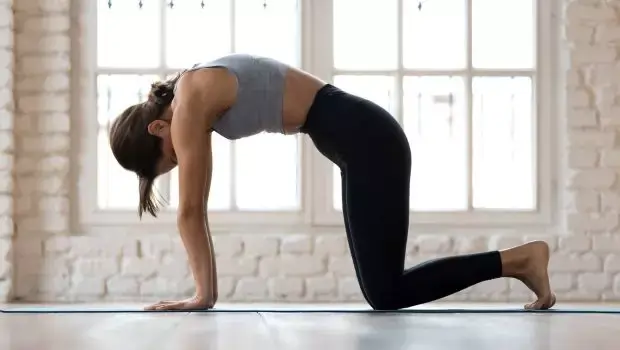11 Best Somatic Exercises For Weight Loss
Introduction:
Focusing on mind and body awareness in somatic exercises for weight loss improves mental health and reduces stress. Weight loss can be greatly helped by both eliminating emotional eating and getting better sleep.
It focuses on the internal experience of the action to help you better understand your bodily sensations and what your body is trying to tell you. Somatic exercises help keep your cortisol levels under control by lowering stress and improving sleep, which can help you avoid overeating to manage stress that could otherwise result in weight gain.
Somatic activities strengthen the mind-body connection. By releasing tension from the body, these focused exercises help your nervous system function at its best while also creating a sense of security and peace. By practicing mindful movement daily, you can stimulate your parasympathetic nerve system, which is in charge of the body’s rest and digestion reaction.
While conventional exercises are helpful, somatic exercises offer a way to deal with the psychological and emotional components of weight in addition to improving physical health. This comprehensive approach can result in significant and long-lasting improvements, which makes somatic exercises helpful for overall good health and wellness.
Somatic exercises don’t need to take a long time. Even a few minutes each day will greatly reduce stress and encourage good weight control.
Types of somatic exercises:
There are many different types of somatic exercises, ranging from easy, focused movements to more intricate and challenging postures.
You can experiment with various somatic exercises and approaches, such as;
Tensing a muscle group for five seconds and then letting it go is known as progressive muscle relaxation (PMR).
- Body scans
By just sitting or lying down comfortably and mentally scanning your entire body from head to toe, you can find any areas of tension that are causing you difficulty. After a few moments of concentrating on that location, breathing in and out until you feel calm and relieved, then repeat the scanning procedure.
- Pilates and Yoga
Somatic yoga is one of many yoga techniques that focus on the mind-body connection by integrating breath therapy, relaxation, and body movement. Some forms of Pilates additionally focus on that connection.
- Martial arts
Many forms of martial arts, especially Aikido, Tai Chi, and Qigong, require a high degree of bodily awareness and attention.
- Walking
Combining walking with meditation and concentration can make it a form of somatic workout.
Advantages of Somatic Exercise:
- Improved mind-body awareness
You can better understand and become more conscious of how your emotions affect your physical health by engaging in somatic exercise.
By targeting deep trauma and emotional problems, this increased awareness can have significant therapeutic advantages and improve emotional well-being.
- Lowering of Stress
Slow, delicate movement patterns that help you release tension and relax tense muscles are known as somatic movement. Your heart doesn’t race while you do them. Additionally, meditation is a key component of somatics, which helps reduce stress. Somatic exercises may improve your sleeping patterns while lowering stress. Somatic therapy can be used to treat insomnia.
- Alleviation of pain
Somatic exercises are beneficial for pain relief since they require you to pay close attention to your body’s sensations, especially if you have any injury or areas of pain that need care.
- Improved balance and flexibility
You can improve your mobility by warming up your muscles and increasing blood flow by combining deep breathing with gradual movements.
Somatic Exercises For Weight Loss:
Some somatic exercises that could help you lose weight are as follows;
Walking
A park, garden, or any other area where you may walk without distractions would be a good choice for your focused walk.
- Stand up straight and in a comfortable position to start.
- Maintain a straight posture and allow your arms to hang loosely at your sides.
- Breathe deeply a few times to help you focus on yourself.
- Breathe in via your nose, letting your lungs full, and then gently expel through your mouth.
- Begin at a relaxed, natural pace.
- Focus on the feeling of your feet coming up off the ground and landing on it once more.
- Be mindful of each step.
- Observe how your legs and feet move subtly.
- Keep your attention on how your weight shifts between your feet.
- Keep your eyes forward and relaxed.
- Let your peripheral vision scan the environment without focusing on anything in particular.
- Walking mindfully can be done for a set amount of time, such as ten minutes or more.
- As you gain experience with the practice, gradually extend the duration.
- Then relax.
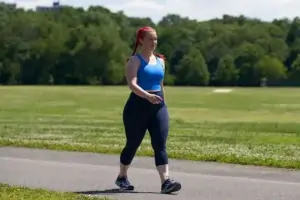
Body Scan Meditation
Focusing on different body parts, carefully analyzing them, and releasing any tension is a mindful activity known as body scan meditation.
- Get comfortable and sit or lie down.
- When you’re sitting position, keep your arms by your sides.
- Make sure your hands are comfortably resting on your lap or knees and that your back is straight when you are seated.
- To reduce outside distractions, close your eyes if you feel comfortable doing so.
- As an alternative, you can keep them open with a kind look.
- Take a few deep, slow breaths to start.
- Let your breathing be comfortable and natural.
- Concentrate on your toes.
- Pay attention to any tension, warmth, or other feelings in this area.
- With every breath, relieve any tightness or pain you may have been feeling.
- Keep going higher while looking over your entire body.
- Focus on your thighs, hips, knees, lower legs, and so forth.
- As you proceed, let go of stress. Become conscious of your chest, upper back, lower back, and abdomen.
- Be mindful of the speed at which you breathe and any sensations in these areas.
- Relax and release any tension in these places.
- Focus now on your face, jaw, neck, and head.
- Be mindful of your emotions and consciously release any tension.
- Lastly, extend your attention to your entire body.
- Understand how everything is interrelated and develop a sense of calm and presence.
- Then relax.
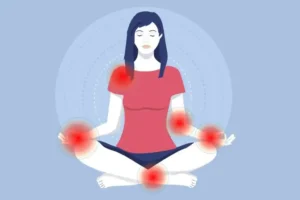
Mountain Pose (Tadasana)
- Bring yourself to a position where your big toes contact.
- All of your toes should be raised and spread out before being lowered again to create a wide, strong base.
- If your ankles are knocking together uncomfortably, you can slightly separate your heels.
- You should let your feet and calves push into the ground.
- Rotating both thighs inward will cause the sit bones to widen.
- Maintain the natural curve of your spine.
- Contract your abdomen gently to tone it.
- Once the shoulder blades are being rolled up to your ears, slide them back to release them down your back.
- Arms should be left relaxed, palms facing front, elbows bent just slightly.
- After you have verified every alignment point, hold yourself in this position for five to ten breaths.
- Then return to your neutral position.
- Then relax.
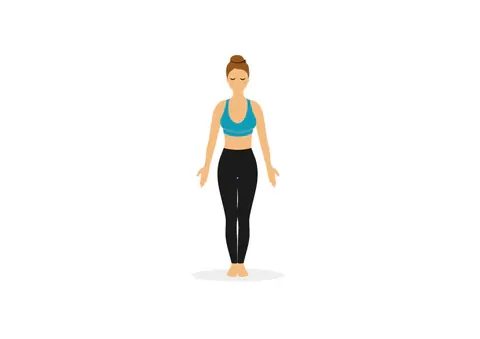
Pigeon pose (Eka Pada Rajakapotasana)
- Stand with your feet hip-width wide.
- You ought to put your arms by your sides.
- Make the front bend while standing.
- Lower your body nearer your legs by leaning at the hips.
- When you fold forward, maintain a straight spine.
- Taking a deep breath, push your right leg forward while maintaining a straight left leg behind you.
- Your right knee should drop near the floor.
- Try to keep your left heel up.
- When you’re done breathing, place the outside of your right shin on the mat.
- Your left hip should be near your right heel.
- Place your left knee on the mat.
- The ceiling should be in front of your left foot.
- The mat in front of you should be where your palms are.
- Your hands can rest on your shins if you find it hard to keep them on the mat.
- Lengthen your spine after raising your chest.
- Keep your eyes gentle as you look forward.
- Hold this position for a few seconds.
- Then return to your neutral position.
- Then relax.
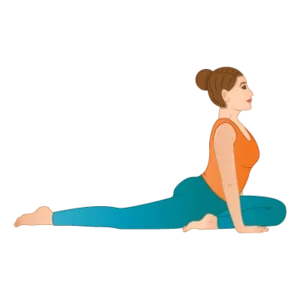
Vrksasana (tree pose)
- Start with a standing position.
- Spread your toes, flex your leg muscles, and plant your feet firmly on the mat.
- Lift your front hip points toward your lower ribs to gently squeeze your lower abdomen.
- Please take a deep breath that raises your chest, then release it as you pull your shoulder blades down your back.
- Look directly to a stable area for gazing.
- Your right foot should be raised high onto your left thigh or shin, and your hands should be on your hips.
- Avoid making contact with your knee.
- Your right foot and left leg should be pressed together.
- Make sure the front of your body is level with your pelvis.
- After you feel secure, join it by extending your arms to the ceiling.
- Hold this position for a few seconds.
- Then return to your neutral position.
- Then relax.
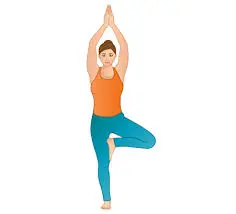
Cat-Cow Stretch (Marjaryasana-Bitilasana)
- Beginning on your hands and knees, place yourself on a tabletop posture.
- To achieve cow posture, take a deep breath and raise your head and tailbone to the ceiling by straightening your back.
- Hold this position for a few seconds.
- Then return to your neutral position.
- As you rotate your spine in the cat position, exhale and pull your chin and tailbone together.
- Gently move while focusing on the sensations in your spine and core.
- Hold this position for a few seconds.
- Then return to your neutral position.
- Then relax.
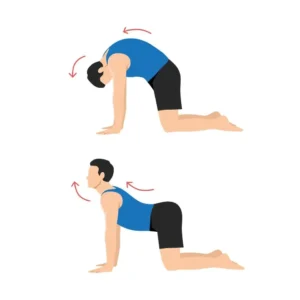
Leg Lifts
- Take a supine posture.
- The first leg should remain grounded as you slowly elevate the other leg to the ceiling.
- Tighten your lower abdominal muscles while you elevate your leg, paying attention to the feeling of the movement.
- Hold this position for a few seconds.
- Slowly lower your leg, then switch to the other side.
- Then return to your neutral position.
- Then relax.
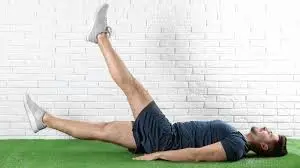
Breath-Centered Bridge Pose (Setu Bandha Sarvangasana)
- Resting on your back.
- Next, bend both knees.
- Using your core and glutes, press your feet onto the floor.
- Lift your hips to the ceiling while taking a deep breath.
- Hold this position for a few seconds.
- Breathe out slowly as you return your hips to the floor.
- Then return to your neutral position.
- Then relax.
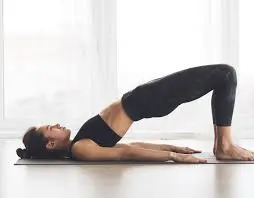
Child’s Pose (Balasana)
- Get into a sitting position on your heels on the floor to begin.
- Make sure your heels are almost touching each other.
- Move your weight such that your sit bones rest on your heels.
- Straighten your arms while holding your hands out in front of you.
- With your chest resting on your thighs, place your forehead on the ground.
- Put your elbows, hands, and forearms on the ground in front of you.
- As you breathe in, extend the back of your body, and as you exhale, release it into the mat.
- Hold this position for a few seconds.
- Then return to your neutral position.
- Then relax.
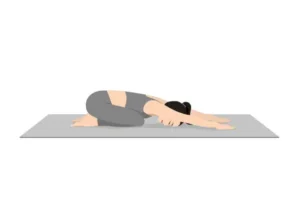
Seated forward bend (Paschimottanasana)
- Assume a sitting position on the ground first.
- Taking a breath, extend both arms toward the ceiling, keeping them parallel to your ears.
- Continue reaching forward as you release your breath, bending forward and extending your hands toward your toes.
- Your nose should touch your legs.
- If your toes are out of reach, grasp your ankles, shins, or even your knees.
- Hold this position for a few seconds.
- Then return to your neutral position.
- Then relax.
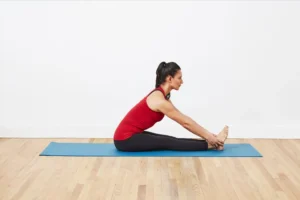
Side Plank (Vasisthasana)
- Place your feet flat on top of each other while lying on your right side.
- Place your right elbow under your right shoulder as your forearm is pointing away from you and your hand tightly squeezed into a fist.
- Breathe out while keeping your neck neutral and tensing your core.
- Using the side of your right foot and your elbow to support your weight, raise your hips off the mat.
- Maintain a straight body alignment among your ankles and head.
- Hold this position for a few seconds.
- Then return to your neutral position.
- Then relax.
- Continue on your left side.
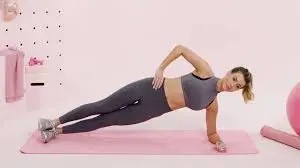
What precautions should be taken when working out?
- Spend five minutes warming up and cooling down after each workout to avoid pain and injury.
- Any pain during your workout should be stopped right away, and if it continues, you should see a doctor.
- Consult your physician before starting a new fitness program or increasing your level of activity.
- Avoid eating soon before or right after your outing if you’re hungry, and eat a small lunch before working out. Additionally, wearing clothing that is overly tight or trendy is not a good choice.
- Focus and self-awareness exercises may help you avoid falls when exercising.
- When exercising, stay away from harsh or violent motions.
- When working out, be careful to keep a good posture.
- As you gain strength, slowly raise the number of sets and repetitions.
- To get maximum benefit out of your workout, take deep, regular breaths.
- Keep your eyes on yourself and stay focused to prevent falling while working out.
- Wearing clothing that fits well and is loose enough to move freely will maximize the benefits of your training.
When will you stop working out?
- Fever
- Blurry vision
- Headache
Advice on how to lose weight:
A person may be able to lose weight by changing their lifestyle in addition to performing somatic activities, including;
- Making an effort to reduce weight
Understanding the importance of weight loss is beneficial. For instance, controlling weight may help reduce a person’s risk of heart disease if the problem runs in the family. Weight loss objectives might be strengthened by putting them in writing.
- Tracking present emotions and experiences
People can keep track of their sleep patterns, activities, and everything they eat and drink. They are also able to record their feelings and stress.
- Developing achievable goals
A person can develop reasonable goals by using the data they collect about their lifestyle choices. Walking or including veggies in every evening meal are two ways to increase exercise levels. Specific objectives, like walking for fifteen minutes three times a week, are effective.
To get the most benefits, how many somatic exercises should you perform each day?
You can greatly improve your somatic exercise results by prioritizing quality over quantity when organizing your daily routine.
To get the greatest advantages, try doing one or two targeted exercises per day. You can focus more on each exercise with this method, which guarantees that you complete them accurately and carefully.
Important Things to Think About;
- The Key Is Repetition
Your body can more quickly achieve a condition of balance and relaxation if you perform a few exercises regularly.
- Pay Attention to Your Body
The body reacts differently in each person. To keep things balanced, pay attention to how your body feels and modify the amount of repetitions properly.
- Pay Attention to the Opinion
Focusing on fewer exercises will allow you to perform each one more thoroughly, increasing your awareness and gradually improving your results.
Summary:
The phrase “somatic exercise” defines a slow, attentive, body-focused movement that focuses on the mind-body connection and wants to develop body awareness and balance.
All of the physical advantages of somatic movements, such as reduced pain, improved coordination and flexibility, and increased strength, will only improve your regular workouts and indirectly help in weight loss.
Engaging in somatic exercises can increase a person’s awareness of their body’s sensations and help them understand that adopting new habits and enjoying others can result in a better lifestyle.
In line with your whole wellness journey, somatic exercises provide a unique and very personal experience. You can develop a greater awareness of your body and even change the way you approach exercise and health by concentrating on the internal sense of movement.
FAQ:
Are somatic exercises beneficial for weight loss?
A person may be able to lose weight by improving their mind-body connection through somatic workouts.
What is somatic exercise?
Techniques for somatic exercises are based on non-Western mind-body practices, which are often classified as somatics and emphasize the connection between physical experience and emotional and mental states.
Does walking qualify as a somatic workout?
These are a subset of somatic therapy, which stresses meditation and body awareness. Aikido, tai chi, dance, yoga, Pilates, and mindful walking are a few examples of these workouts.
Is somatic yoga effective?
Regular somatic movement exercises may help people with their posture, range of motion, flexibility, and balance. Using somatic stretching to improve your mind-body connection may help you improve your overall health.
How frequently ought I to perform somatic exercises?
Make an effort to include somatic practices in your daily routine, even if you can only dedicate a few minutes to them. Breathe deeply a few times to begin your day, or stretch as you work.
What are somatic exercises for fat around the belly?
Somatic activities might not immediately spring to mind when you’re looking to reduce belly fat, but they can be quite beneficial. Martial arts, yoga, Pilates, progressive muscle relaxation, dancing, and simply walking are some of these workouts.
Are somatic workouts effective?
Somatic exercises can indeed help lower stress, increase body awareness, and foster a good body image. All of these elements support a comprehensive strategy for managing weight.
References:
- C. Mateus (2024, Dec. 20). The advantages of somatic workouts for weight loss are being investigated. How to Lose Weight with Somatic Exercises https://www.myjuniper.com/blog/
- L. Martin (2024, Nov. 7). Somatic exercises for losing weight. You can find articles about somatic exercises for weight loss at https://www.medicalnewstoday.com.
- T. Neurofit (2024, Sept. 26). NEUROFIT: Somatic Exercises for Weight Loss. https://neurofit.app/blog/posts/somatic-exercises-to-help-with-weight-loss | NEUROFIT
- On December 26, 2024, Chalicha, E., and Ms, S. A. Ten Physical Activities to Help You Let Go of Pent-Up Feelings. BetterMe Blog. “somatic exercises” is an article on https://betterme.world.
- F. Lover (2024, Dec. 1). Top Somatic Workouts to Reduce Weight. A fan of fitness. How to Lose Weight with the Best Somatic Exercises https://thefitnesslover.com/
- G. Brent (2024, Nov. 25). How Does Weight Loss Through Somatic Yoga Work? Yoga Training in its entirety. Weight loss with somatic yoga: https://www.allyogatraining.com/somatic-yoga
- Image 2, Dr. L. Ferguson (2020, July 22). Developing Peace During a Stressful Period: How to Perform a Basic “Mindful Body Scan” Meditation. https://creakyjoints.org/living-with-arthritis/mental-health/mindful-body-scan-meditation-anxiety-chronic-illness/ The Creaky Joints website
- Image 3, June 14, 2021: Patel, S. Pelvic Floor Strengthening Yoga Pose List: Five. Pilates poses for pelvic floor strength. Myinnovo. https://www.myinnovo.com/blogs/innovo/5
- Image 5, yogaclassplan.com. 2021a, 23 June. Yoga Class Plan. com’s Tree Pose is one of the yoga poses. vrksasana tree yoga pose: https://www.yogaclassplan.com/yoga-pose/
- Image 7, M. Hurford (2023, Jan. 26). The True Health Benefits of Leg Lifts. Health Digest. This article explains the true health benefits of leg lifts: https://www.healthdigest.com/401284/

